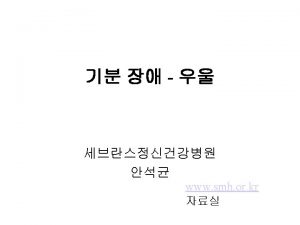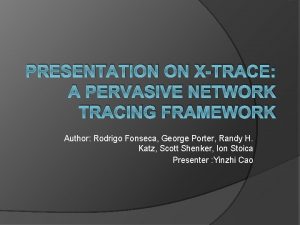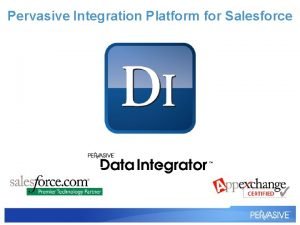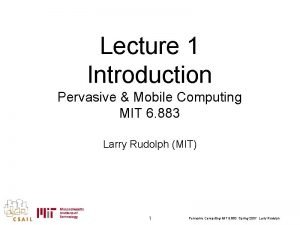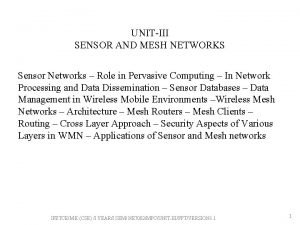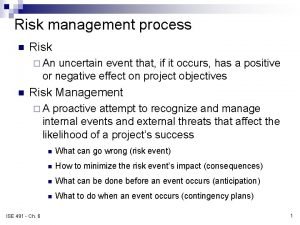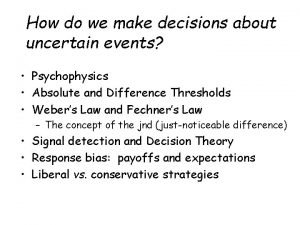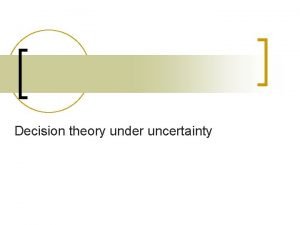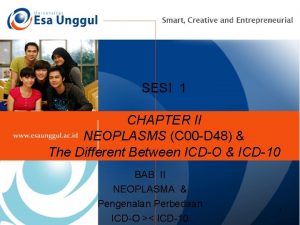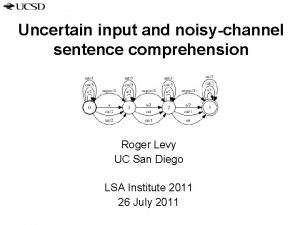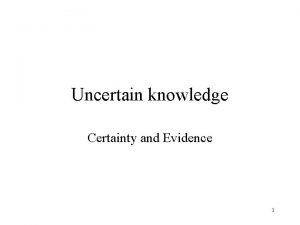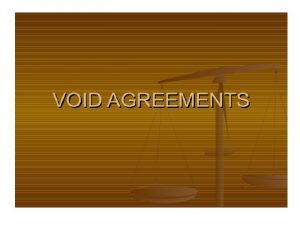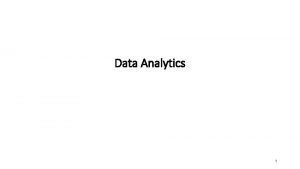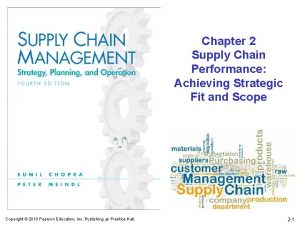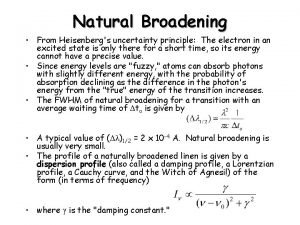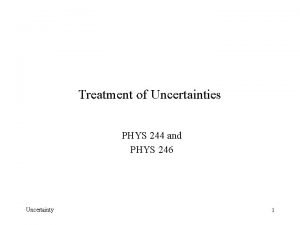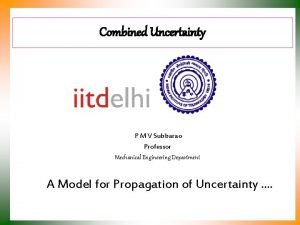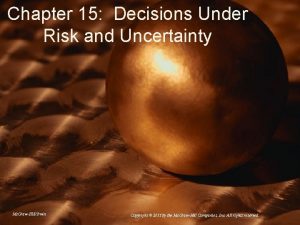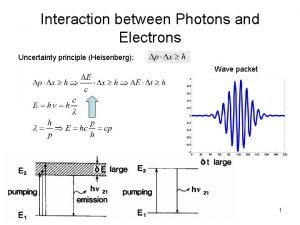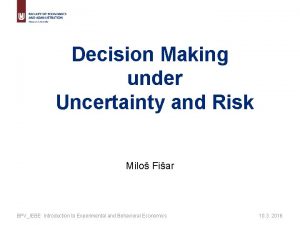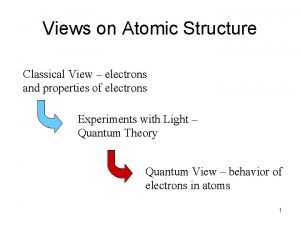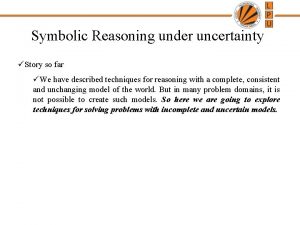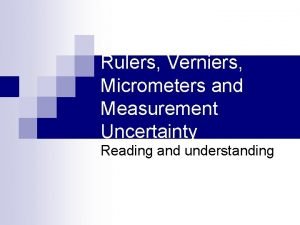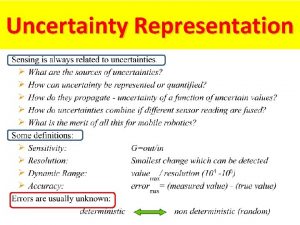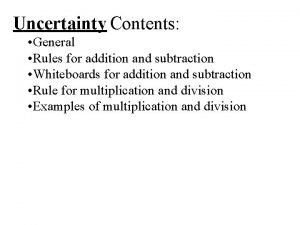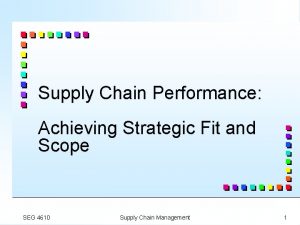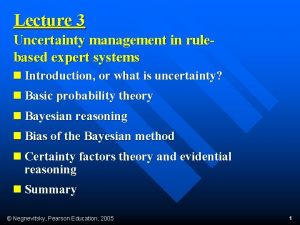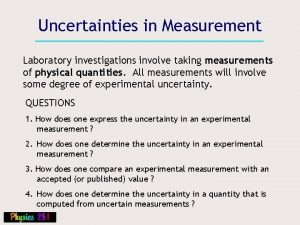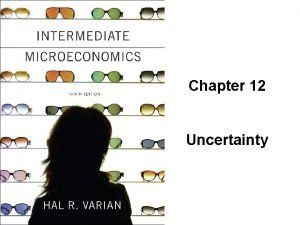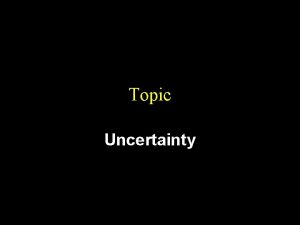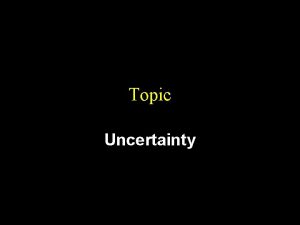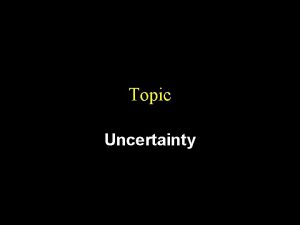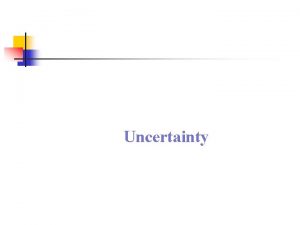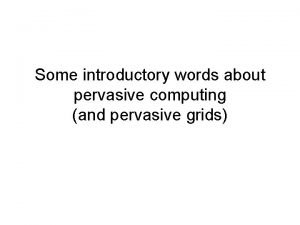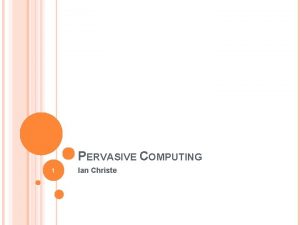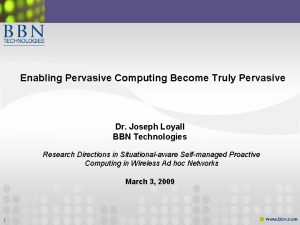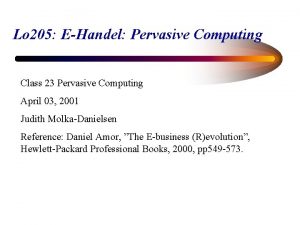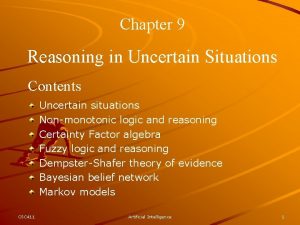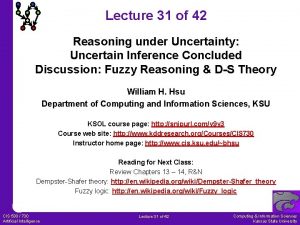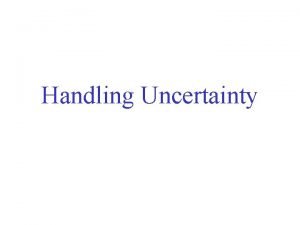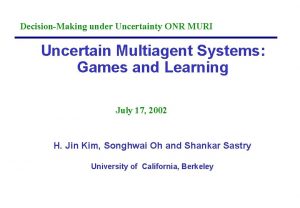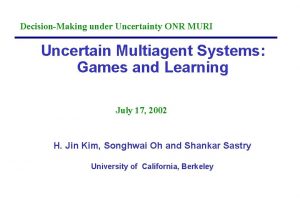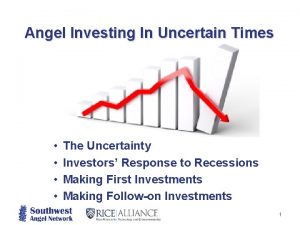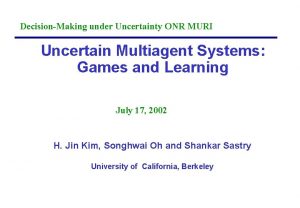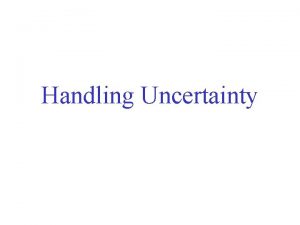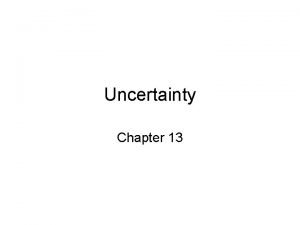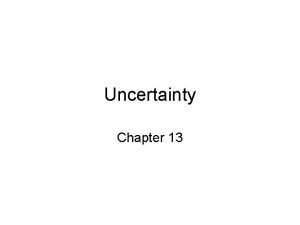Uncertainty is Pervasive u What is uncertain in


























![Choice Under Uncertainty [Q] How is a rational choice made under uncertainty? [A] Choose Choice Under Uncertainty [Q] How is a rational choice made under uncertainty? [A] Choose](https://slidetodoc.com/presentation_image/7768e2b424767d0a4d05cb61341dcff0/image-27.jpg)

















- Slides: 44

Uncertainty is Pervasive u What is uncertain in economic systems? – future prices – future availability of commodities – present and future actions of other people

Uncertainty is Pervasive u What are rational responses to uncertainty? – buying insurance (health, life, auto) – a portfolio of contingent consumption goods.

States of Nature (SON) u Possible SONs: – car accident (a) – no car accident (na) occurs with probability a, does not with probability na : u Accident a + na = 1. u Accident causes a loss of $L.

Contingencies u. A contract implemented only when a particular SON occurs is statecontingent. u E. g. : the insurer pays only if there is an accident.

Contingencies u. A state-contingent consumption plan is implemented only when a particular SON occurs. [Example] take a vacation only if there is no accident.

State-Contingent Budget Constraints $1 of accident insurance costs u Consumer has $m of wealth u Cna is consumption value in the noaccident state. u Ca is consumption value in the accident state. u Each

State-Contingent Budget Constraints Cna A state-contingent consumption with $17 consumption value in the accident state and $20 consumption value in the no-accident state. 20 17 Ca

State-Contingent Budget Constraints u Without insurance: Ca = m – L Cna = m

State-Contingent Budget Constraints Cna m The endowment bundle Ca

State-Contingent Budget Constraints u Buy $K of accident insurance Cna = m - K Ca = m - L - K + K = m - L + (1 - )K

State-Contingent Budget Constraints u Buy $K of accident insurance u Cna = m - K u Ca = m - L - K + K = m - L + (1 - )K u So K = (Ca - m + L)/(1 - ) u And: Cna = m - (Ca - m + L)/(1 - )

State-Contingent Budget Constraints u Buy $K of accident insurance. u Cna = m - K. u Ca = m - L - K + K = m - L + (1 - )K. u So K = (Ca - m + L)/(1 - ) u And Cna = m - (Ca - m + L)/(1 - ) u I. e. :

State-Contingent Budget Constraints Cna m Endowment Ca

State-Contingent Budget Constraints Cna m Where is the most preferred state-contingent consumption plan? Ca

Preferences Under Uncertainty u Think of a lottery. u Win $90 with p=1/2, and win $0 with p=1/2. u U($90)=12 U($0) = 2

Preferences Under Uncertainty u Expected utility is:

Preferences Under Uncertainty u Expected is: money value of the lottery

Preferences Under Uncertainty u EU = 7 and EM = $45 u U($45) > 7 $45 for sure is preferred to the lottery risk-averse u U($45) < 7 the lottery is preferred to $45 for sure risk-loving u U($45) = 7 the lottery is preferred equally to $45 for sure risk-neutral

Preferences Under Uncertainty U($45) > EU risk-averse 12 U($45) MU declines as wealth rises. EU=7 2 $0 $45 $90 Wealth

Preferences Under Uncertainty U($45) < EU risk-loving 12 MU rises as wealth rises. EU=7 U($45) 2 $0 $45 $90 Wealth

Preferences Under Uncertainty U($45) = EU risk-neutral 12 U($45)= EU=7 MU constant as wealth rises. 2 $0 $45 $90 Wealth

Preferences Under Uncertainty u State-contingent consumption plans that give equal expected utility are equally preferred.

Preferences Under Uncertainty Cna Indifference curves EU 1 < EU 2 < EU 3 EU 2 EU 1 Ca

Preferences Under Uncertainty u What is the MRS of an indifference curve? u Get consumption c 1 with prob. 1 and c 2 with prob. 2 ( 1 + 2 = 1) u EU = 1 U(c 1) + 2 U(c 2) u For constant EU: d. EU = 0

Preferences Under Uncertainty

Preferences Under Uncertainty Cna Indifference curves: EU 1 < EU 2 < EU 3 EU 2 EU 1 Ca
![Choice Under Uncertainty Q How is a rational choice made under uncertainty A Choose Choice Under Uncertainty [Q] How is a rational choice made under uncertainty? [A] Choose](https://slidetodoc.com/presentation_image/7768e2b424767d0a4d05cb61341dcff0/image-27.jpg)
Choice Under Uncertainty [Q] How is a rational choice made under uncertainty? [A] Choose the most preferred affordable state-contingent consumption plan.

State-Contingent Budget Constraints Cna m endowment Affordable plans Where is the most preferred state-contingent consumption plan? Ca

State-Contingent Budget Constraints Cna m More preferred Ca

State-Contingent Budget Constraints Cna Most preferred affordable plan m Ca

State-Contingent Budget Constraints Cna MRS = slope of budget line m Ca

Competitive Insurance u Suppose entry to the insurance industry is free. u Expected economic profit = 0: K - a. K - (1 - a)0 = ( - a)K = 0 u I. e. : free entry = a u Insurance is actuarially fair, if: price of $1 insurance = accident probability.

Competitive Insurance u When insurance is fair, rational insurance choices satisfy: u I. e. : u Marginal utility of income must be the equal in both states.

Competitive Insurance u How much fair insurance does a riskaverse consumer buy? u Risk-aversion MU(c) as c u Hence: u I. e. full-insurance

Unfair Insurance u Suppose insurers make positive expected economic profit. u I. e. K - a. K - (1 - a)0 = ( - a)K > 0 u Then > a

Unfair Insurance u Rational choice requires u Since u Hence for a risk-averter. u I. e. a risk-averter buys less than full unfair insurance.

Uncertainty is Pervasive u What are rational responses to uncertainty? – buying insurance (health, life, auto) – a portfolio of contingent consumption goods [Franco ? Modigliani (Nobel 1985, 1918 -2003)]

Diversification u Two firms, A and B. Shares cost $10. u With p=½: A’s profit is $100; B’s profit is $20 u With p=½: A’s profit is $20; B’s profit is $100 u You have $100. How to invest?

Diversification u Buy only firm A’s stock? u $100/10 = 10 shares. u You earn $1000 with p=1/2, and $200 with p=1/2. u Expected earning: $500 + $100 = $600

Diversification u Buy only firm B’s stock? u $100/10 = 10 shares. u You earn $1000 with p=1/2, and $200 with p=1/2. u Expected earning: $500 + $100 = $600

Diversification u Buy 5 shares in each firm? u You earn $600 for sure. u Diversification has maintained expected earning and lowered risk.

Diversification u Typically, diversification lowers expected earnings in exchange for lowered risk.

Risk Spreading/Mutual Insurance u 100 risk-neutral persons each independently risk a $10 K loss. u Loss probability = 1% u Initial wealth is $40 K u No insurance: expected wealth is

Risk Spreading/Mutual Insurance u Mutual insurance: Expected loss is u Each of the 100 persons pays $1 into a mutual insurance fund u Mutual insurance: expected wealth is u Risk-spreading benefits all ex ante!
 Pseudodementia
Pseudodementia Mobile computer wikipedia
Mobile computer wikipedia Mobile and pervasive computing
Mobile and pervasive computing X-trace: a pervasive network tracing framework
X-trace: a pervasive network tracing framework Pervasive developmental disorder screening test
Pervasive developmental disorder screening test Pdd disorder
Pdd disorder Pervasive integration
Pervasive integration Pervasive and mobile computing
Pervasive and mobile computing Pervasive and mobile computing
Pervasive and mobile computing Specific and pervasive boundaries for behavior
Specific and pervasive boundaries for behavior Pervasive computing ppt
Pervasive computing ppt Example of uncertain event
Example of uncertain event Uncertain events
Uncertain events Certain vs uncertain digits
Certain vs uncertain digits Indifference curve risk averse
Indifference curve risk averse Icd 10 ca nasofaring
Icd 10 ca nasofaring Levy in a sentence
Levy in a sentence Representing knowledge in an uncertain domain
Representing knowledge in an uncertain domain Agreement the meaning of which is uncertain is
Agreement the meaning of which is uncertain is Relative uncertainty formula
Relative uncertainty formula Which decision model incorporates the uncertainty element
Which decision model incorporates the uncertainty element Zone of strategic fit
Zone of strategic fit Performance cycle uncertainty
Performance cycle uncertainty How to express certainty
How to express certainty Measurement uncertainty
Measurement uncertainty Uncertainty relation and natural line width
Uncertainty relation and natural line width Heisenberg uncertainty principle statement
Heisenberg uncertainty principle statement Edward t hall
Edward t hall Cmc uncertainty
Cmc uncertainty How to calculate experimental uncertainty
How to calculate experimental uncertainty Combined standard uncertainty
Combined standard uncertainty Medical uncertainty
Medical uncertainty Uncertainty vs risk
Uncertainty vs risk Heisenberg uncertainty principle
Heisenberg uncertainty principle Uncertainity in decision making
Uncertainity in decision making D orbital shape
D orbital shape Maxwell equation tattoo
Maxwell equation tattoo Minimalist reasoning
Minimalist reasoning Uncertainty of micrometer
Uncertainty of micrometer Uncertainty propagation
Uncertainty propagation Peters uncertainty in acoustics (epub|pdf|mobi)
Peters uncertainty in acoustics (epub|pdf|mobi) Uncertainty in subtraction
Uncertainty in subtraction Zone of strategic fit
Zone of strategic fit Uncertainty management in rule-based expert systems
Uncertainty management in rule-based expert systems Standard deviation
Standard deviation
